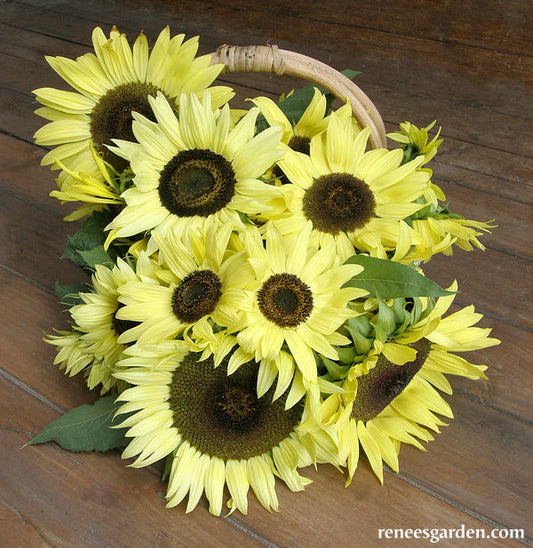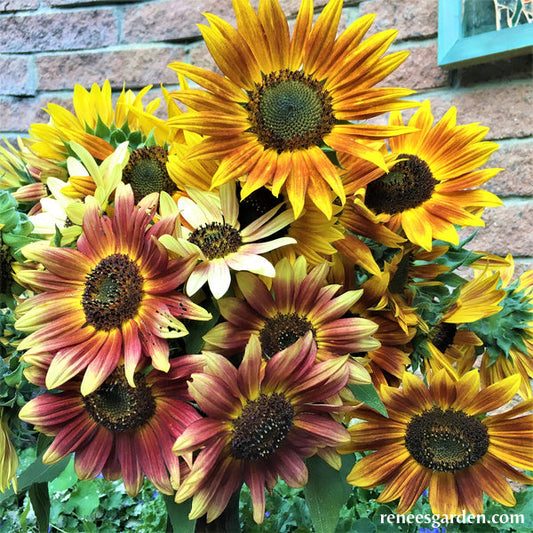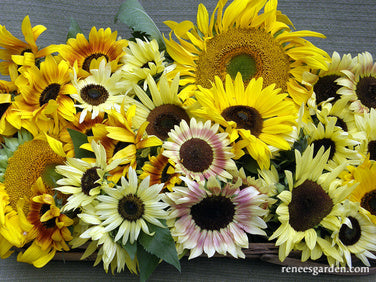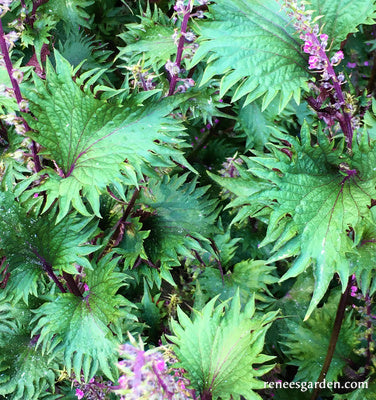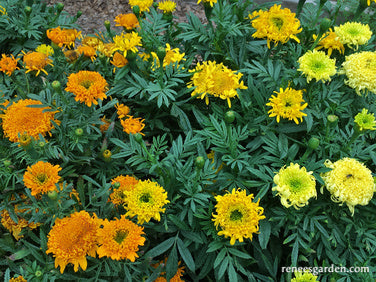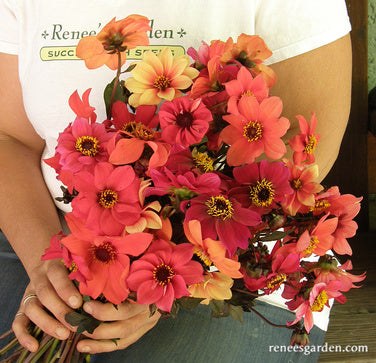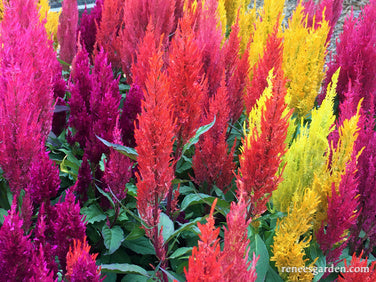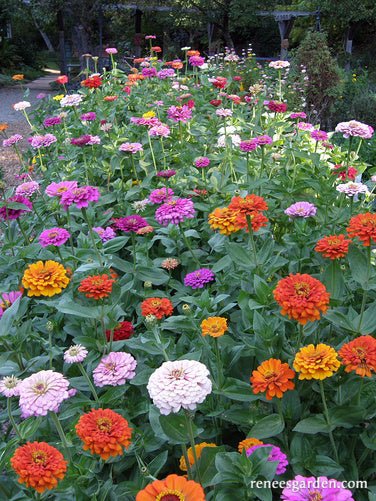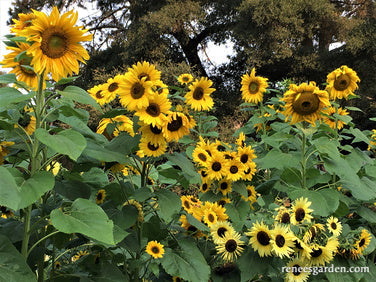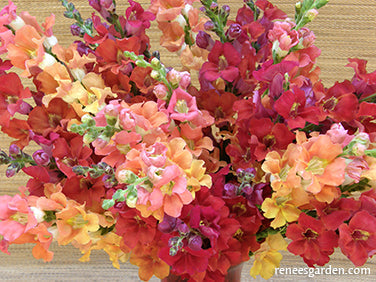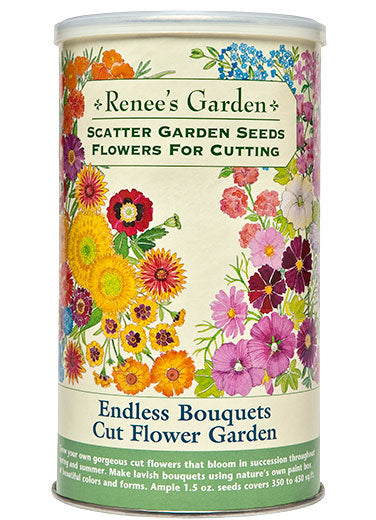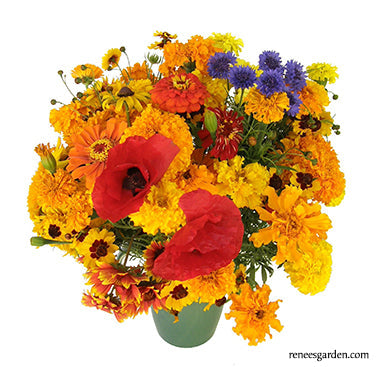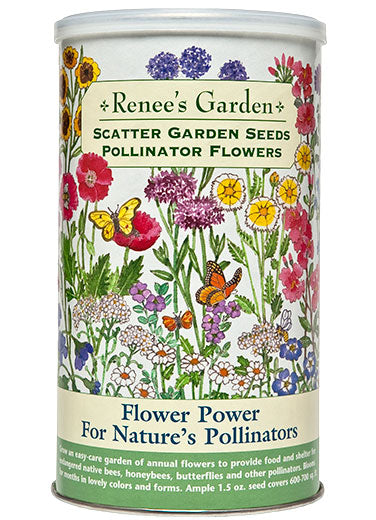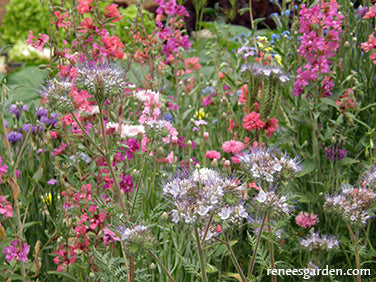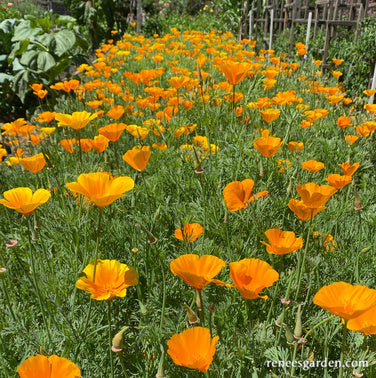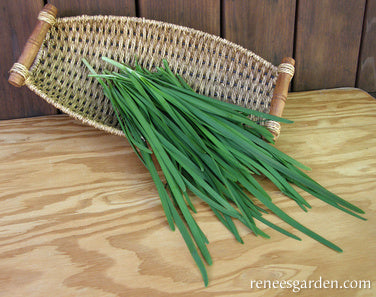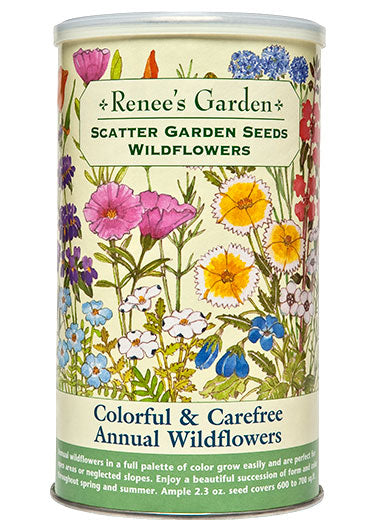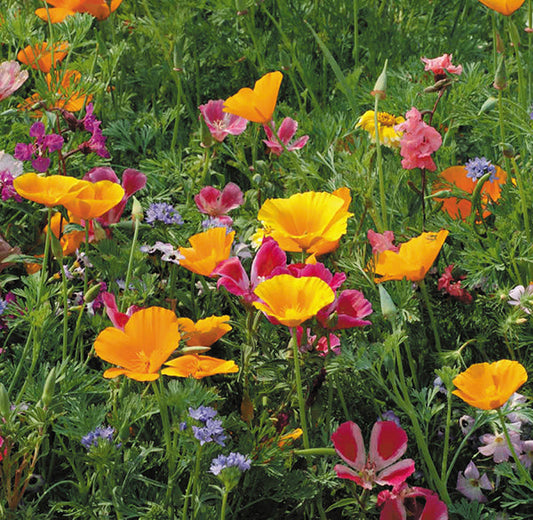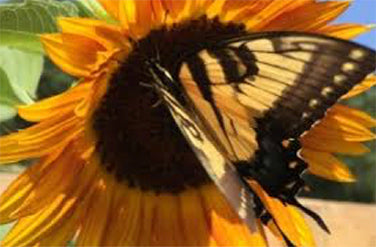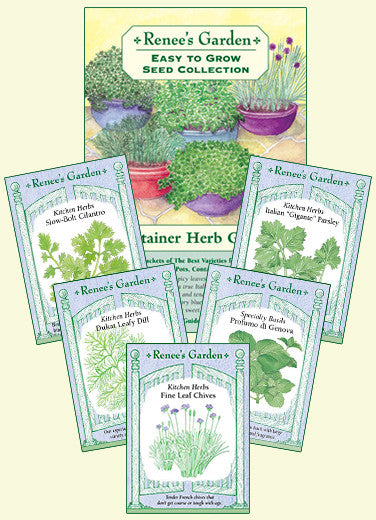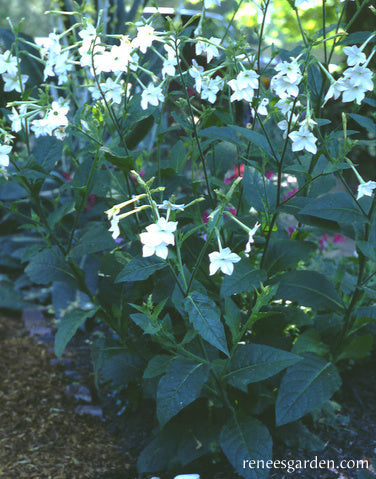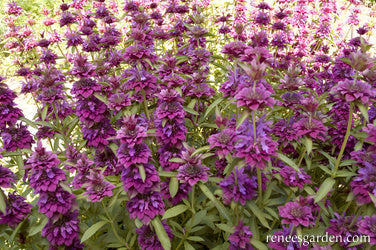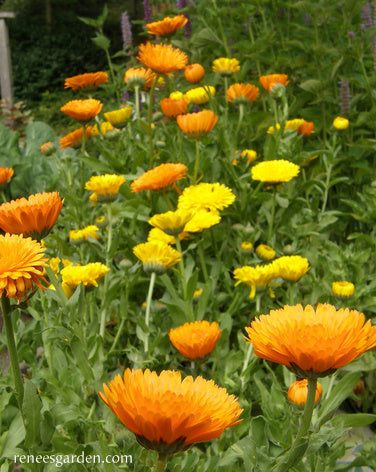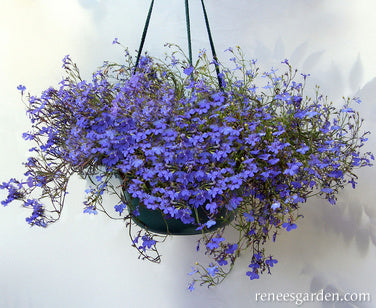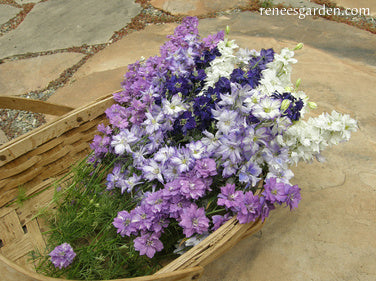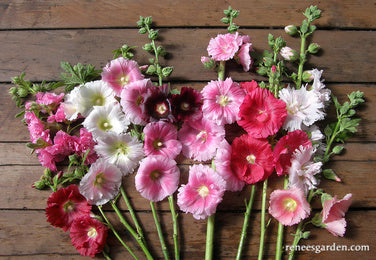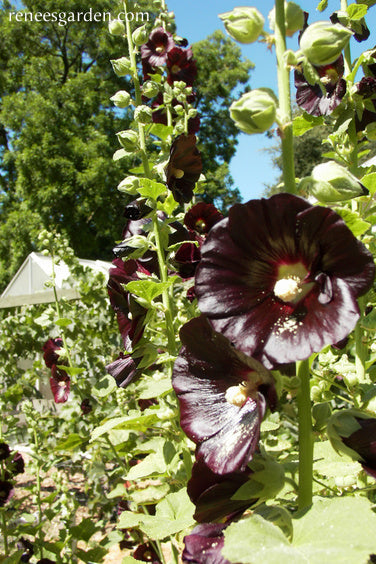Attracts Butterflies
Enjoy Enchanting "Flowers of the Air"
These blossom shapes and colors will bring butterflies to the garden all summer long to feed, rest and roost.
-
Pollinator Sunflowers Lemon Queen
ANNUAL
Summer/fall bloom
Frost tenderEASIEST TO DIRECTLY PLANT OUTDOORS
Plant in full sun in good garden soil only when weather is warm and settled, all danger of frost is past and both days and nights are evenly in the 50°F (10°C) range. Poke individual seeds into well-worked soil about 1/2 in. deep, 4 to 5 in. apart. Press the soil firmly over the seeds and keep the seedbed evenly moist until seedlings emerge in 8 to 10 days.
Important: when the seedlings are well-established, carefully thin them to a final spacing of 1 foot apart; this way they will have enough room to develop sturdy stalks that won’t blow over and big clusters of flowers. Any extra seedlings you remove can be transplanted elsewhere in the garden or potted up and given to friends.
GROWING NOTES
Growing these colorful sunflowers for pollinators and bouquets is both easy and rewarding. Make several sowings several weeks apart and you’ll have a succession of flowers in full bloom. Keep soil moist and well weeded and protect very young seedlings from birds with bird netting held tautly above the seedbed with supports, or use plastic berry baskets, removing baskets before plants get crowded.Regular price $3.39Sale price $3.39Unit price / per -
Pollinator & Songbird Sunflowers Paintbox Bouquet
ANNUAL
Summer/fall bloom
Frost tenderEASIEST TO PLANT OUTDOORS
Plant in full sun in good garden soil when weather is warm and settled, all danger of frost is past and both days and nights are evenly in the 50°F (10°C) range. Poke seeds into well-worked soil about 1/2 in. deep, 4 to 5 in. apart. Press soil firmly over seeds and keep moist until seedlings emerge in 8 to 10 days. Important: when seedlings are well-established, thin them to a final spacing of 1 foot apart so plants can grow sturdy stalks and big flowers. Extra seedlings can be transplanted easily.
TO START EARLY INDOORS
Several weeks before last frost date, sow seeds ½ inch deep in individual pots of well-drained seed starting mix. Keep moist and provide a strong light source until seedlings are well established and ready to plant outside. Transplant carefully, disturbing the roots as little as possible. Space seedlings 1 foot apart so plants will have room to grow and mature.
GROWING NOTES
Growing these colorful sunflowers for pollinators and bouquets is both easy and rewarding. Make several sowings several weeks apart to have a succession of flowers in full bloom. Keep soil moist and well weeded and protect very young seedlings from birds with netting or plastic berry baskets, removing before plants get crowded.
Regular price $4.89Sale price $4.89Unit price / per -
Heirloom Summer Garden Dancing, Joyous Sunflowers
NOTE
Seeds in this canister are packed with a larger quantity of organic rice hulls to help space them. Before opening, shake canister thoroughly to mix.
HOW TO PLANT AND GROW
When spring weather is warm and settled, and nights are reliably above 50°F (10°C), prepare the planting area by removing all weeds, grass, large clumps and stones. Loosen the top 2 inches of soil with a digging fork or shovel, then smooth with a flat rake.
Scatter mix thinly and evenly. Using your rake, work to cover the seeds with 1/2-1 inch of soil, then use planting mix or compost to cover any exposed seed mix. Water thoroughly with a gentle mist.
Keep weeded and watered; protect tiny seedlings from birds by using netting or ribbons of shiny, reflective flash tape at planting time. When 3-4 inches tall, remove covering and thin seedlings to 10-12 inches apart. This spacing is critical for sturdy, windproof plants with good root systems and large flowers.
HARVEST AND USE
For bouquets, cut when flowers just begin to open. Many diverse pollinators will busily visit the florets in each flower head and seeds will begin to mature. When the center disk florets have dried, birds will happily snack on ripening seed heads.
Harvest for winter feeding by covering ripening heads with paper bags until kernels are plump and hard shelled. Cut entire heads; store until cool and dry, then remove seeds. Store in closed containers to feed as needed.
Regular price $16.95Sale price $16.95Unit price / per -
Ornamental Edibles Bicolored Shiso
ANNUAL
Summer/fall harvest
Heat-loving, frost tenderTO PLANT DIRECTLY INTO THE GARDEN
When late spring weather has thoroughly warmed up, sow seeds 1 inch apart in well worked fertile soil in full sun. Cover 1/4 inch deep, firm soil and keep seedbed moist. Germination takes 1 to 2 weeks. After seedlings are well established, thin or transplant 8 inches apart to allow plants room to mature.
TO START EARLY INDOORS
Sow seeds 1 inch apart in a container of seed starting mix, 4 to 6 weeks before last expected frost. Keep warm and evenly moist, and provide a good light source. When seedlings are large enough to handle and night temperatures are solidly above 50°F (10°C ), acclimate gradually to outdoor conditions before planting in the garden 8 inches apart.
GROWING NOTES
Remember— it is critical to plant Shiso in the garden only after day and nights are solidly above 50°F (10°C). Pinch off growing tips when plants are 6 to 8 inches tall to encourage branching. Harvest sprays of leaves by cutting stems just above two new sprouting lateral branches to get lush regrowth.
NOTE: Can self-sow aggressively. Keep plants from spreading by cutting spent flowers so they don't drop seeds. Do not plant near natural areas.
Regular price $3.99Sale price $3.99Unit price / per -
Butterfly Flowers Spinning Wheels Marigolds
ANNUAL
Summer/fall bloom
Frost tenderTO PLANT OUTDOORS
Sow seeds directly into well-worked garden soil in full sun once all danger of frost is past. Space seeds several inches apart and cover about 1/4 inch deep. Keep soil evenly moist while awaiting germination in 7 to 10 days. When seedlings are well established, thin them to a final spacing of 8 to 10 inches apart so these vigorous plants have room to grow and bloom. Extra thinned seedlings can be transplanted easily.
TO START EARLY INDOORS
Sow seeds several inches apart in a container of well-drained seed starting mix 4 to 6 weeks before last expected frost date. Cover 1/4 inch deep, keep moist and provide a strong light source until ready to go outside. Transplant 8 to 10 inches apart once weather warms up after gradually acclimating seedlings to outdoor conditions.
GROWING NOTES
These cheerful marigolds are quick to bloom, carefree and non-fussy. Their profusion of long lasting flowers and handsome blue-green foliage is perfect in any sunny spot and makes long blooming handsome borders. Feed and water regularly. No need to pinch these self branching productive plants. Both butterflies and pollinators of all kinds are attracted to these flowers throughout the season.
Regular price $3.39Sale price $3.39Unit price / per -
Pollinator Dahlias Blazing Saddles
PERENNIAL GROWN AS ANNUAL
Frost tender
Summer/Fall BloomBEST TO START EARLY INDOORS
Sow seeds 2 inches apart in containers of seed starting mix, 4 to 6 weeks before last spring frost. Cover 1/2 inch deep, keep moist and warm and provide a strong light source until ready to plant outdoors. When weather is warm and settled, acclimate seedlings gradually to outdoor conditions. Plant 12-14 inches apart in full sun.
TO START DIRECTLY OUTDOORS
Wait until weather is warm and settled and night temperatures are above 50°F (10°C). Sow groups of 2 to 3 seeds 1/2 inch deep and 12-14 inches apart in well-worked, fertile soil in full sun. Cover lightly and keep soil moist but not soggy while awaiting germination. When well-established, thin carefully, leaving one single seedling per group, so plants have room to grow. Keep well-weeded and evenly watered.
GROWING NOTES
Encourage growth and plentiful flowers by feeding plants monthly. Remove faded flowers to prolong bloom. These dahlias will produce underground tubers after their first season of bloom.
In mild winter climates: tubers can overwinter in the ground.
In cold winter climates: dig up the tubers in late fall to replant next spring.Container Growing: Space seedlings 8 in. apart in containers at least 16-18 in. across and 16 in. tall.
Regular price $3.99Sale price $3.99Unit price / per -
Rainbow Plume Celosia Hippie Tie Dye
ANNUAL
Summer/fall color
Frost tenderBEST TO START EARLY INDOORS
Six weeks before last expected frost date, sow seeds 1 inch apart in a container of seed starting mix. Cover very lightly, no more than 1/8 inch. Keep warm and moist and provide a strong light source until seedlings are ready to plant out in the garden. Feed every 2 weeks with half-strength fertilizer.
Seedlings are ready to transplant when they are large enough to handle and night temperatures are evenly in the 50°F (10°C) range. Gradually acclimate seedlings to outdoor conditions, then plant in full sun 6 to 8 inches apart in rich, fertile soil.
TO START OUTDOORS
Sow seeds in a well-drained, finely textured seed bed in full sun when weather is warm and nights are above 50°F (10°C). Space seeds 2 to 3 inches apart and cover very lightly, then gently firm soil. Keep soil evenly moist while awaiting germination When seedlings are large enough to handle, thin or transplant 6-8 inches apart in full sun.
GROWING NOTES
Seedlings grow slowly at first, then vigorously by midsummer. Good drainage is essential. The dramatic plumes in their eye-catching color collage bloom hard and last all summer. Cut for colorful bouquets or hang bunches upside down inside to air dry as “everlasting” flowers.Regular price $4.99Sale price $4.99Unit price / per -
Heirloom Rainbow Flowers Colorful, Carefree Zinnias
NOTE
Seeds in this canister are packed with a larger quantity of organic rice hulls to help space them. Before opening, shake canister thoroughly to mix.
HOW TO PLANT AND GROW
When spring weather is warm and settled, and nights are reliably above 50°F (10°C), prepare planting area by removing all weeds, grass, stones and large clumps. Loosen the top 2 inches of soil with a digging fork or shovel, then smooth with a flat rake.
Scatter mix thinly and evenly. Using your rake, work to cover the seeds with 1/2 inch of soil, then use planting mix or compost to cover any exposed seed mix. Water thoroughly with a gentle mist.
Protect tiny seedlings from birds by using netting or ribbons of shiny, reflective flash tape at planting time. Keep weeded and watered; when 3 inches tall, remove covering and thin seedlings to 8-10 inches apart for good air circulation and enough elbow room to grow, branch and bloom freely.
HARVEST AND USE
For bouquets, pick just as flowers open, cutting long stems well back into the plant to keep them branching. Butterflies, bees, and other native pollinators will seek out and work these pretty flowers that provide them with nectar, pollen and shelter.
Zinnias are carefree and long-lasting, but will thrive and bloom longer with proper thinning, regular watering and several applications of organic fertilizer over their long flowering season.
Regular price $16.95Sale price $16.95Unit price / per -
Bonus Pack An Heirloom Sunflower Forest
ANNUAL
Spring/summer bloom
Frost tenderEASIEST TO PLANT OUTDOORS
Plant in full sun in good garden soil only when weather is warm and settled, all danger of frost is past and both days and nights are evenly in the 50°F (10°C) range. Poke individual seeds into well-worked soil about 1/2 in. deep, 4 to 5 in. apart. Press the soil firmly over the seeds and keep the seedbed evenly moist until seedlings emerge in 8 to 10 days.
Important: when the seedlings are well-established, carefully thin them to a final spacing of 1 foot apart; this way they will have enough room to develop sturdy stalks that won’t blow over and big clusters of flowers. Any extra seedlings you need to remove can be transplanted elsewhere in the garden or potted up and given to friends.
TO START EARLY INDOORS
Several weeks before last frost date, sow seeds 1/2 inch deep in individual pots of well-drained seed starting mix. Keep moist and provide a strong light source until seedlings are well established and ready to plant outside. Transplant carefully, disturbing the roots as little as possible. Space seedlings 1 foot apart so plants will have room to grow and mature.
GROWING NOTES
Growing these colorful sunflowers for pollinators and bouquets is both easy and rewarding. Make several sowings several weeks apart and you’ll have a succession of flowers in full bloom. Keep soil moist and well weeded. Protect very young seedlings from bird predation by covering the bed with bird netting held tautly well above seedlings by supports. Or use plastic berry baskets, removing before plants get crowded.
Regular price $8.99Sale price $8.99Unit price / per -
Butterfly Snapdragons Chantilly Summer Flame
HARDY ANNUAL
Spring/Summer/Fall bloom.
Can handle light frostSTART SEEDS INDOORS
Start seeds indoors in a container of seed starting mix in early spring 6 to 8 weeks before the last expected frost. Dampen soil mix evenly before sowing. Sow seeds 1 inch apart, covering only with a fine dusting of mix. Keep evenly moist but not soggy and provide a strong light source until ready to plant outdoors. When seedlings have several sets of leaves, transplant them 2 inches apart into a deeper container. After they reach 2 to 3 inches tall, gradually acclimate sturdy, well-established seedlings to outdoor conditions before transplanting in full sun.
THIN OR TRANSPLANT
Space seedlings 10 to 12 inches apart for best performance.
GROWING NOTES
Heat and wind-resistant Chantilly adds height, color and texture to garden beds and provides abundant gorgeous summer bouquets. Feed and water well and keep spent flower stalks cut off for longest bloom season. Cut stalks when 8-10 blossoms are open; do not crowd in the vase for best, longest lasting cut flowers. In mild climates, snapdragons can also be planted in late fall to overwinter and bloom as a spring flower.
Regular price $4.99Sale price $4.99Unit price / per -
Endless Bouquets Cut Flower Garden
NOTE
The seed mix is packed with a larger quantity of organic rice hulls to help space the tiny seeds. Before opening, shake canister thoroughly to mix them together.
HOW TO PLANT
As soon as ground can be worked in early spring, sow mix in ordinary garden soil in full sun. In mild climates, where the ground does not freeze hard in winter, seeds can also be planted in late fall to over-winter and bloom the next spring.
Prepare the planting area by removing all weeds, grass and large stones. Break up soil clumps and evenly loosen the top 2 inches of soil with a digging fork or shovel, then smooth out with a flat rake.
Shake can thoroughly, then scatter the contents thinly and evenly over prepared ground. Using your rake, lightly cover the seed mixture, about ¼ inch deep, and then lightly firm the soil. Water evenly with a gentle mist. Keep bed moist while awaiting germination and when the seedlings are small.
GROWING NOTES
Harvesting opening flowers regularly for bouquets will help to encourage repeat bloom. Plants will flower in succession and bloom much longer if watered regularly. At season’s end, allow spent flowers to form pods and then drop their seeds to bloom again next spring.
ANNUAL CUTTING FLOWER MIX
NAME MIX% TYPE HEIGHT COLOR Aster
(Callistephus chinensis)2 A 12 - 36" Blue/Pink/White/Purple Calendula
(Calendula officinalis)10 A 12 - 24" Yellow/Orange/Cream Bachelor Buttons
(Centaurea cyanus)8 A 12 - 36"
Blue/RoseWhite Godetia
(Clarkia amoena)2 A 10 - 18" Pink/White Clarkia
(Clarkia elegans)3 A 10 - 18" Pink/Lavender Plains Coreopsis
(Coreopsis tinctoria)3 A 12 - 36" Yellow-Maroon Cosmos
(Cosmos bipinnatus)7 A 36 - 60" White/Pink/Crimson/Rose Chinese Forget-Me-Not
(Cynoglossum amabile)10 A/B 18 - 24" Blue Larkspur
(Delphinium ajacis)3 A 12 - 36" White/Pink/Blue/Violet African Daisy
(Dimorphotheca aurantiaca)5 A 10 - 16" Orange/Salmon/White Poppy
(Eschscholzia californica)2 TP 12 - 18" Yellow/Orange Annual Gaillardia
(Gaillardia pulchella)2 A 12 - 24" Yellow-Red Baby's Breath
(Gypsophila elegans)8 A 8 - 18" White Sunflower
(Helianthus annus)
2 A 24 - 72" Yellow Strawflower
(Helichrysum monstrosum)
1 A 24 - 36" Yellow/White/Red/Pink Candytuft
(Iberis umbellata)
5 A 12 - 18" White/Pink/Violet Lavatera (Tree Mallow)
(Lavatera trimestris)2 A 24 - 48" White/Pink Alyssum Tall (Sweet Alyssum)
(Lobularia maritima)
5 TP 8 - 16" White Evening Primrose
(Oenothera lamarckiana)
1 B/P 24 - 60" Yellow Shirley Poppy
(Papaver rhoeas)
3 A 12 - 30" White/Pink/Red California Bluebells
(Phacelia campanularia)
1 A 8 - 20" Blue Black Eyed Susan
(Rudbeckia hirta)
5 A/B/P 12 - 36" Yellow Catchfly
(Silene armeria)
2 A/B 16 - 22" Pink Marigold
(Tagetes erecta)
3 A 12 - 16" Yellow/Orange/Maroon Zinnias
(Zinnia elegans)
5 A 12 - 36" White/Purple/Yellow/Orange/Red
Inert Material: Organic rice hulls
A = Annual B = Biennial TP = Tender PerennialRegular price $16.95Sale price $16.95Unit price / per -
Flower Power For Nature's Pollinators
NOTE
The seed mix is packed with a larger quantity of organic rice hulls to help space the tiny seeds. Before opening, shake canister thoroughly to mix them together.
HOW TO PLANT
As soon as ground can be worked in early spring, sow mix in ordinary garden soil in full sun. In mild climates, where the ground does not freeze hard in winter, seeds can also be planted in late fall to overwinter and bloom the next spring.
Prepare the planting area by removing all weeds, grass and large stones. Break up soil clumps and evenly loosen the top 2 inches of soil with a digging fork or shovel, then smooth out with a flat rake.
Shake the can thoroughly, then scatter the contents thinly and evenly over the prepared ground. Using your rake, lightly cover the seed mixture, about 1/4 inch deep, and then lightly firm the soil. Water thoroughly and evenly with a gentle mist. Keep soil bed evenly moist while awaiting germination and when the seedlings are small. Water regularly for best blossoms.
GROWING NOTES
Plants will flower in succession and bloom much longer if watered regularly. At season’s end, allow spent flowers to form pods and then drop their seeds to bloom again next spring.
ANNUAL POLLINATOR FLOWER MIX
INDIVIDUAL VARIETY NAMESMIX% Chinese Forget-Me-Not19.6Baby Blue Eyes19.6 Single Chinese Aster9.8 Cornflower, ‘Polka Dot Mix’9.8Shirley Poppy
7.8 Sweet Mignonette
7 Tidy Tips
4.9 Virginia Stock10 Creeping Daisy3 Clarkia3 Globe Gilia2.9 Lemon Mint2 California Bluebell2 Lacy Phacelia1.5 Tall White Alyssum1 Plains Coreopsis1 Inert Material: Organic rice hulls Regular price $16.95Sale price $16.95Unit price / per -
California Native Orange Poppies
NOTE
The Poppy seeds in this can are packed with a larger quantity of milled rice hulls to help space the tiny seeds when scattering.
Before opening, shake the can thoroughly to mix them together so when you cast the seeds they are spaced with room for the plants to grow.
HOW TO PLANT
In mild winter climates, where the ground does not freeze hard, poppies can be sown in late fall to overwinter for spring bloom. Or, plant as early as possible in spring, as poppies can handle light frosts and bloom longest when given a good start in cool weather.
To prepare the planting area: remove all weeds, grass and large stones. Break up soil clumps and evenly loosen the top 2 inches of soil with a digging fork or shovel, then smooth out with a flat rake.
Shake the can thoroughly before opening, then scatter the contents thinly and evenly over the prepared ground. Using your rake, cover the seed mixture 1/4 inch deep and lightly firm the soil. Water with a gentle mist thoroughly and evenly. Keep the soil moist while awaiting germination and while the seedlings are small.
GROWING NOTES
Mature poppy plants can handle dry conditions, but will thrive and bloom much longer if watered regularly. Poppies make lovely cut flowers if brought indoors just as the buds begin to open. At season’s end, let spent flowers form pods and drop seeds to bloom again the next spring.
Regular price $16.95Sale price $16.95Unit price / per -
Heirloom Herbs Garlic Chives
PERENNIAL
Spring/summer/fall harvest
Frost hardyTO PLANT DIRECTLY OUTDOORS
In the cool weather of early spring, sow clusters of 7 to 10 seeds 8 to 10 inches apart in well-worked, fertile soil in sun or part shade. Cover 1/4 inch deep and press soil firmly over seeds. Keep evenly moist as seeds germinate slowly over several weeks. Emerging seedlings have slender, straight leaves.
TO START EARLY INDOORS
In early spring, sow seed thinly in a container of seed starting mix and cover 1/2 Inch deep. Keep evenly moist as seedlings slowly emerge and provide a good light source. Gradually acclimate to outdoor conditions before transplanting clusters of 7 to 10 seedlings, planting each cluster 8 inches apart.
GROWING NOTES
Garlic chives grow slowly at first, but soon mature into sturdy bright green mounds crowned with pretty white edible blossoms. After bloom finishes, shear entire plant back to 4 inches to encourage regrowth of tender new leaves. These hardy, self-sufficient plants are attractive additions to the flower or herb garden.Regular price $4.89Sale price $4.89Unit price / per -
Colorful & Carefree Annual Wildflowers
NOTE
Seeds are packed with a larger quantity of milled rice hulls to help space the tiny seeds when scattering. Before opening, shake the can thoroughly to mix them together so when you cast the seeds they are spaced with room for the plants to grow.
HOW TO PLANT
As soon as the ground can be worked in early spring, plant the seeds in ordinary garden soil in full sun. In mild climates, where the ground does not freeze hard in winter, seeds can also be planted in late fall to overwinter and bloom the next spring.
To prepare the planting area: remove all weeds, grass and large stones. Break up soil clumps and evenly loosen the top 2 inches of soil with a digging fork or shovel, then smooth out with a flat rake.
Shake the can thoroughly before opening, then scatter the contents thinly and evenly over the prepared ground. Using your rake, cover the seed mixture 1/4 inch deep and lightly firm the soil. Water with a gentle mist thoroughly and evenly. Keep the soil moist while awaiting germination and while the seedlings are small.
GROWING NOTES
When wildflower plants are mature they can handle somewhat dry conditions, but will thrive and bloom much longer if watered regularly. For indoor bouquets, cut the flowers as blossoms open. At season’s end, let spent flowers form pods and drop seeds to bloom again the next spring.
WILDFLOWER MIX
INDIVIDUAL VARIETY NAMES MIX% Candytuft
Iberis umbellata18 Baby Blue Eyes
Nemophila menziesii
16 Five Spot
Nemophila maculata
16 Chinese Houses
Collinsia heterophylla12 African Daisy
Dimorphotheca aurantiaca8 CA Poppy
Eschscholzia californica7 CA Bluebell
Phacelia campanularia5 Shirley Poppy
Papaver rhoeas5 Bird’s Eyes
Gilia tricolor4 Dwarf Godetia
Clarkia amoena2 Clarkia
Clarkia unguiculata2 Globe Gilia
Gilia capitata2 Tidy Tips
Layia platyglossa2 Inert Material: Clean milled rice hulls NOTE
The seed mix is packed with a larger quantity of organic rice hulls to help space the tiny seeds. Before opening, shake canister thoroughly to mix them together.
Regular price $16.95Sale price $16.95Unit price / per -
Bonus Pack Seeds for A Butterfly Garden
TWO DESIGN IDEAS
Plant your butterfly garden in a rectangular bed or border with tall, medium and low flowers from back to front, OR in a circle with tall flowers in the center, surrounded by the middle and then lower growing varieties.
For the back of the border in dramatic rows, OR planted in a circle garden as a central spiral, tall, branching Crimson Queen sunflowers offer both a convenient meal and a windscreen for your winged visitors.
At mid-level, Purity Cosmos' abundant snow-satiny white flowers with sunny centers dance and sway all summer, a magnet for air-waltzing butterflies.
At front of the border OR around the outer edge of the circle, low-growing Persian Carpet zinnias offer a beautiful tapestry of warm shades and provide nectar for many species.
CREATING BUTTERFLY HABITATButterflies are attracted to blossom shapes and colors, so it's important to plant in mass blocks instead of a few isolated plants here and there. Planting these flowers behind each other produces an ideal combination of different flowers at varying heights, offering your visitors a choice of where to feed and rest.
These flowers provide flower nectar for nourishment and fuel butterflies need for flying. Flowers unique personal attributes of color, scent and shape lure butterflies and ensure pollination. With each sip from the heart of a blossom, tiny grains of pollen gather on the butterfly’s body and then it helps to pollinate the garden as it flutters among flowers.
Sunny days in the garden are synonymous with a busy freeway of flying butterflies. The sun warms their wing muscles, enabling them to dart, soar and fly seeking nectar and pollinating your sun loving flowers. On gusty summer days, the taller cosmos and sunflowers offer comfortable protection from the wind. Offer butterflies a convenient drinking spot with a shallow bird bath or decorative stone water container.
Regular price $8.99Sale price $8.99Unit price / per -
Easy To Grow Collection The Container Herb Garden
Having an abundance of fresh herbs at your fingertips is a delicious luxury and growing our Container Herb Garden means you will have all their aromas and flavors available to enjoy everyday. These herbs are all easy to grow kitchen essentials; they also make lovely ornamental plants and have flowers that attract pollinators. The varieties in this collection are specially chosen to grow well in containers, pots or window boxes. The back of each packet has complete growing instructions and our "how-to" guide is also included to ensure success for anyone new to growing in containers.Includes Five Packets Of The Best Varieties For Growing Your Own Delicious Fresh Herbs In Pots, Containers Or Window Boxes.
Slow Bolt Cilantro: The spicy green leaves of this cilantro are essential for Mexican and Asian dishes and brighten up everyday cooking. Our variety holds its leaves longer than others.
Profumo di Genova Basil: This imported Italian basil offers long luscious harvests of big glossy leaves with an intense basil aroma and especially rich flavor. Exquisite with tomatoes and perfect for cooking all summer long.
Fine Leaf Chives: These succulent and tender chives keep their slender, flat shape and don't get coarse or tough all season. Their pretty and edible lilac-pink blossoms have a mild, sweet flavor.
Dukat Dill: This heirloom variety, originally from Denmark, is known for its abundance of finely cut green leaves that can be used fresh longer than other varieties. Wonderful fresh in salads and with cooked vegetables or use with poultry, in potato salad and for making pickles.
Italian Parsley: The handsome plants of this imported heirloom have large, shiny flat leaves that are known for an exceptionally mellow sweet flavor. Wonderful fresh in salads and sandwiches and absolutely delicious in soups, casseroles and stews.
Special Feature: Two Page Guide To Container Gardening
Regular price $16.95Sale price $16.95Unit price / per -
Heirloom Nicotiana Jasmine Alata
PERENNIAL GROWN AS ANNUAL
Summer/fall bloom
Can handle light frostTO START OUTDOORS
Sow seed directly into a finely textured, well-worked garden bed in sun or in partial shade once danger of spring frost is past. Cover very lightly and keep moist as seedlings emerge. Weed and water young seedlings carefully and thin to stand 1 1/2 to 2 feet apart before they get too crowded.
TO START EARLY INDOORS
Start seed indoors 6 to 8 weeks before last spring frost date. Sow seeds as thinly as possible in a container of seed starting mix and cover very lightly. Keep moist but not soggy, and provide a strong light source until seedlings are ready to plant outdoors after gradually acclimating to outdoor conditions. Thin or transplant seedlings 1 1/2 to 2 feet apart to allow room to grow.
GROWING NOTES
Nicotiana grows well in sun but can tolerate shade, especially during the afternoon. In mild areas, plants will winter over; cut back in fall for spring regrowth and early bloom. Plant them with other showy annuals like cosmos or cleome for an old-fashioned country garden.
Regular price $2.99Sale price $2.99Unit price / per -
Butterfly Monarda Bergamo Bouquet
(Monarda hybrida)
Bergamo is an outstanding new annual Monarda with intense, rose-purple flower spikes whose blossoms whirl in clusters around the stems. Bergamo flowers earlier and longer than any other Monarda variety. Plants are compact, 2 1/2 feet tall, heat tolerant and mildew resistant. These lovely flowers are true butterfly magnets, bloom abundantly for several months and make wonderful bouquets. A beautiful new cultivar of old-fashioned cottage garden flowers.Regular price $4.39Sale price $4.39Unit price / per -
Butterfly Calendula Mix Orange & Lemon Twist
HARDY ANNUAL
Spring/fall bloom
Takes light frostTO START OUTDOORS
Calendulas bloom best in cool weather, so plant in early spring in well-drained soil after danger of frost is over. Sow seeds 1 in. apart, cover 1/2 in. deep, firm soil and keep seed bed moist while awaiting germination in 7 to 14 days. After seedlings are well established, thin or transplant 8 in. apart.
Container growing: plants also grow and bloom well in pots at least 12 to 16 in. deep and 18 to 20 in. across. Start with fresh potting mix each season, keep well watered and fertilize monthly.
TO START EARLY INDOORS
In early spring, sow seeds 1 in. apart in a container of seed starting mix and cover ½ in. deep. Keep evenly moist as seedlings emerge and provide a good light source until ready to plant outdoors. Transplant when seedlings are about 2 to 3 in. tall after gradually acclimating plants to outdoor conditions.
GROWING NOTES
Thin seedlings to proper spacing for good air circulation and to discourage mildew. Keep faded flowers removed. Lemon & Orange Twist are easy to grow spring annuals, producing sturdy plants soon covered with bright flowers that bloom nonstop and attract butterflies for many weeks. In mild climates: sow again in late summer for winter or early spring flowers.
Regular price $3.39Sale price $3.39Unit price / per -
Windowbox Lobelia Blue Heaven
ANNUAL
Spring/summer/fall bloom
Frost tenderBEST TO START SEEDS EARLY INDOORS
In early spring, about 6 weeks before last spring frost, sow these tiny seeds thinly in a container of seed starting mix, but do not cover seeds, just press lightly into the soil and gently mist to keep moist until germination. Keep evenly moist and about 65-75°F (18-24°C). Provide a strong light source. When seedlings are large enough to handle and night temps reach 50°F (10°C), gradually acclimate to outdoor conditions. Transplant in little clumps of 4 to 5 seedlings about 5 inches apart in well-drained soil in sun or part shade.
Container Growing: Transplant seedlings into pots or baskets that are at least 10 to 12 inches across and 10 to 12 inches tall. Fill with moistened fresh potting mix, then transplant small clumps of 4 to 5 seedlings several inches apart and water gently. Be sure to keep Lobelia in containers well watered and feed with all-purpose fertilizer every few weeks for continual profuse bloom. Shear spent flowers back for reblooming.
GROWING NOTES
Whether used as a gorgeous groundcover color accent or for a trailing window box or patio container display, this lovely Lobelia will bloom longest if it has rich, moist soil, so don’t forget to water regularly as needed and fertilize frequently.
Regular price $3.39Sale price $3.39Unit price / per -
Bouquet Larkspur Singing the Blues
HARDY ANNUAL
Spring/summer bloom
Frost hardyBEST TO PLANT DIRECTLY IN THE GARDEN
In mild winter climates, sow seeds in fall to germinate and form deep roots over the winter for a long spring bloom. In cold winter areas, sow seed as early in spring as soil can be worked. Larkspur can handle frosts and blooms best when plants get a good start in cool spring weather. Sow seeds 1 inch apart in well-drained soil in full sun. Cover 1/4 inch deep, firm soil and keep seed bed moist. Be patient; germination takes 14 to 21 days. After seedlings are well established, about 2 or 3 inches tall, thin to 10 inches apart to allow for good air circulation and discourage disease. Keep plants well watered and weeded for best performance.
GROWING NOTES
Sow seed early, when weather is still cool, to get sturdy plants that will provide many weeks of elegant and beautiful flowers. Cut flowering stalks before individual florets begin to drop for graceful indoor bouquets or air-dry indoors for everlasting arrangements. Larkspur will continue to bloom well into summer if faded flowers are removed. Agrostemma, cornflowers and Bishop’s Lace are classic cutting garden companions for larkspur.
Regular price $3.69Sale price $3.69Unit price / per -
Old Fashioned Hollyhocks Indian Spring
BIENNIAL
Summer/fall bloom
Frost hardyEASIEST TO START DIRECTLY IN THE GARDEN
Plant seeds in full sun in ordinary garden soil in spring after danger of frost is past. Poke seeds into well-worked soil about 1/2 inch deep, 6 to 8 inches apart. Keep moist until seedlings emerge in 7 to 14 days.
TO START EARLY INDOORS
Start seeds indoors about 8 weeks before last expected frost date. Sow two inches apart and 1⁄2 inch deep in flats or individual containers of seed starting mix. Provide a strong light source and keep mix evenly moist until germination takes place. When seedlings are 3 to 4 inches tall, transplant 12 to 18 inches apart after gradually acclimating to outdoor conditions.
THIN OR TRANSPLANT
Space seedlings 12 to 18 inches apart so plants have ample room to mature.
GROWING NOTES
Indian Spring will bloom the first year from seed if planted early in spring. Planted later, it will bloom the following summer. After blossoms fade, cut off the spent flower stalks just above the ground. Fertilize well and continue to water plants as needed, and roots will push another flush of enchanting flower spires that will open in fall.
Regular price $2.99Sale price $2.99Unit price / per -
Heirloom Hollyhocks Black Watchman
BIENNIAL
Summer/fall bloom
Frost hardyEASIEST TO START DIRECTLY IN THE GARDEN
Plant seeds in full sun in ordinary garden soil in spring after danger of frost is past. Poke seeds into well-worked soil about 1/2 inch deep, 6 to 8 inches apart. Keep moist until germination in 7 to 14 days.
TO START EARLY INDOORS
Start seeds indoors about 8 weeks before last expected frost date. Sow 2 inches apart and 1/2 inch deep in flats or individual containers of seed starting mix. Provide a strong light source and keep mix evenly moist to await germination in 7 to 14 days. When seedlings are 3 to 4 inches tall, transplant 18 to 24 inches apart after gradually acclimating to outdoor conditions. Thin or transplant seedlings 18 to 24 inches apart so plants have ample room to mature.
GROWING NOTES
Black Watchman may bloom the first year from seed if planted early in spring. Planted later, it will bloom the following summer. After blossoms fade, cut off the spent flower stalks just above the ground. Fertilize well and continue to water plants as needed, then roots will push another flush of enchanting flower spires to open in fall.
Regular price $3.69Sale price $3.69Unit price / per

